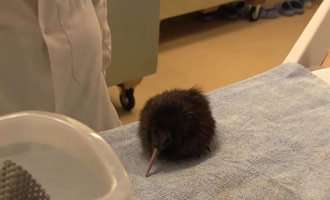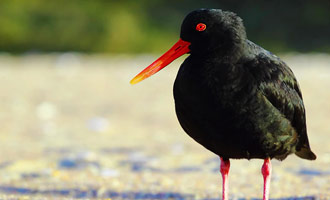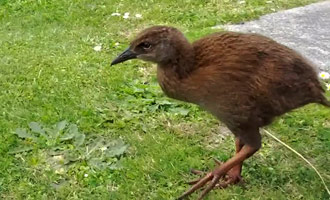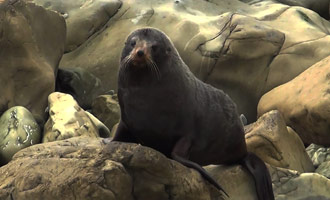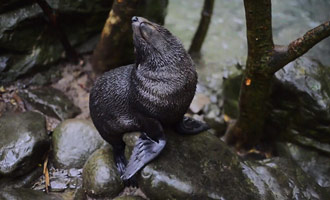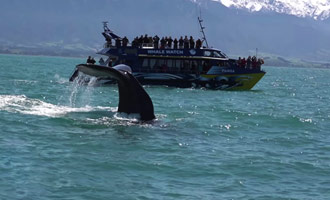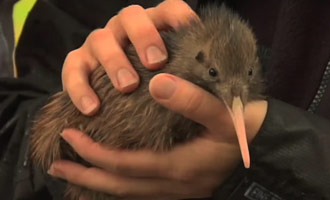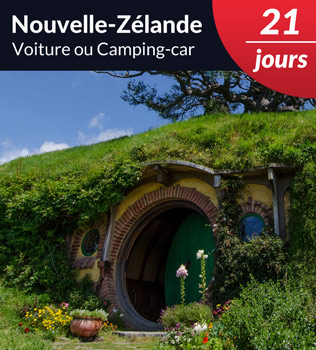
Which Animals to Observe in New Zealand?
Please contact us and we will help you to organize your trip! It's free and without commitment.
- Read the post
- Details
- Advices
The Practical Guide of the Activity.
- 1Discover Unique Species in the World.
- 2The Adorable Kiwi, Mascot of the Country.
- 3The Multicolored Birds of New Zealand.
- 4Meet the Fur Seals.
- 5Watch Whales for Real!
- 6Swimming with Dolphins!
- 7The Possum, a Public Enemy!
- 8Observe Animals Without Disturbing Them.
- 9New Zealand, a Country With 30 Million Sheep.
Discover Unique Species in the World.
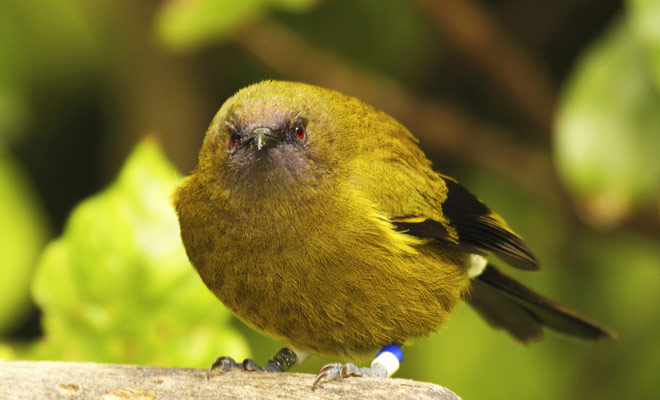
The country was originally populated exclusively by birds.
Separated from the mythical Gondwana continent, New Zealand has drifted for millions of years under the sea. Isolated on the other side of the world, this wild land is home to a wildlife whose most species is unique in the world.
New Zealand is especially renowned for the beauty of its landscapes, but it has other assets. How about watching whales, swimming with dolphins, approaching seals in kayaks or discovering innumerable species of birds and parrots unknown to the general public?
I have set myself the goal of helping you to approach as many different original species as possible during your stay.
I have selected accessible locations close to Kiwipal's itineraries and left out the zoos and aquariums to favor the natural environments (I will make an exception for kiwis).
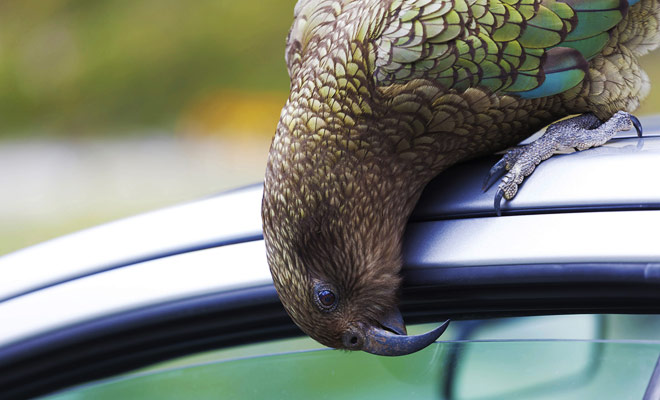
The majority of animal species are endemic.
However, if certain species can be approached within a reasonable distance, others like the penguins are shyer.
It will be necessary to temper your enthusiasm so as not to frighten these creatures accustomed to their tranquility. We will also talk about security, because even if the country does not possess dangerous species for man, there are some guidelines to respect.
New Zealand proves to be a paradise populated by incredible animal species that must absolutely be discovered! This is an additional reason, if you needed one more, to have a dream holiday in the land of kiwis (and sheep ...).
The Adorable Kiwi, Mascot of the Country.
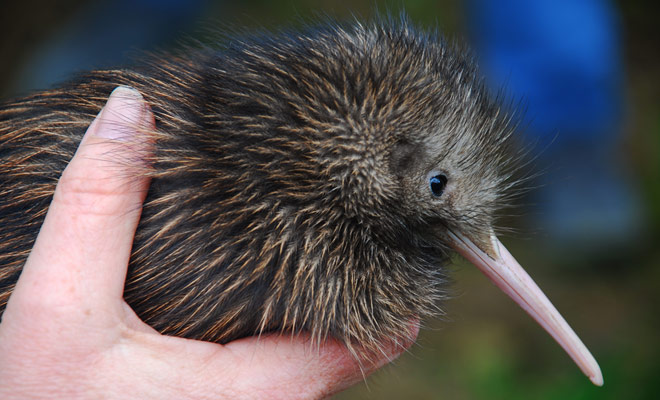
The Kiwi is a bird without wings, threatened with extinction.
The Kiwi is a bird without wings that lives on dry land and spends its hidden existence in forests. Most travelers discover the existence of this strange animal while preparing their stay in New Zealand.
It is sometimes surprising that a country of rugby players and sailors has chosen the most innocuous of birds as an official mascot.
But the affection of the New Zealanders for this curious little animal is easy to explain. The kiwi is cute, comical in its clumsy gait and yet endowed with a true fighting spirit.
Because he only comes out at nightfall to avoid predators, the Kiwi is difficult to observe outside the animal reserves. Fortunately, night outings accompanied by a guide in the Zealandia sanctuary in Wellington are often successful.

Protecting Kiwis might allow them to survive.

A report by National Geographic on the protection of Kiwi in New Zealand.
A report from National GeographicThe park at Rainbow Springs in Rotorua also has a large enclosure for this long-billed bird.
If you return to the park in the evening (your ticket purchased during day-time will still be valid), you can discreetly observe some busy kiwis searching for earthworms in the ground.
In the nature, however, failing to meet a kiwi in the moonlight, you will have a good chance to hear his cry resound in the forest.
Easily recognizable the song of a kiwi changes completely according to whether it is a male or a female.
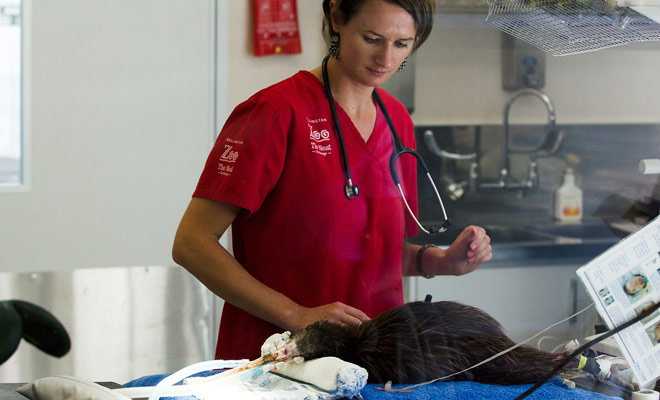
The injured Kiwis are taken care of with the utmost seriousness.
It would be necessary to have a heart of stone not to fall in love with such cute animal! The species is now threatened, so do not miss your chance to observe Kiwis, the next generation might not have such privilege!
The Multicolored Birds of New Zealand.
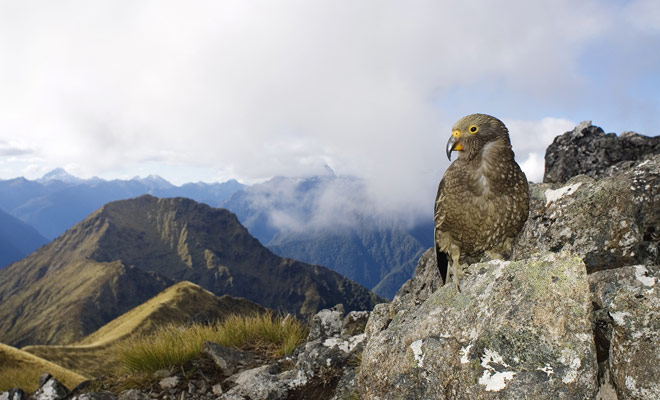
Birds reigned in New Zealand.
Before the coming of man, New Zealand had no terrestrial mammals and the forests of the country resounded only with the song of the birds. Accustomed to spending most of their time on the ground to find food, many species have lost the use of their wings (this is what happened to the famous kiwi).
Rather than draw up an endless list, I will introduce you to the places where you will have the most chance to admire the most famous birds of New Zealand.
Wellington
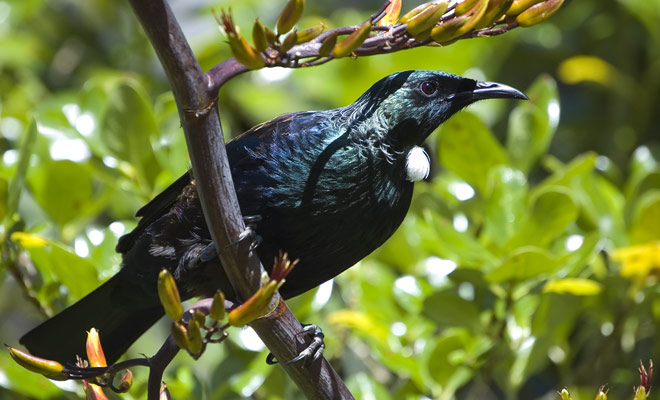
The song of the Tui resembles the beeps ofR2D2 in Star Wars.
Located in the ancient reservoirs of the capital of New Zealand, the nature reserve of Zealandia can be visited with or without a guide.
Nevertheless, the presence of a guide is strongly recommended exploring the kilometers of trails and to know where to look for birds. Perched in the trees, the Kererus and Tuis are magnificent species that are easy to spot.
But the great star of the park is undoubtedly the Kakapo, a parrot threatened with extinction, strangely attracted by the man ...
Abel Tasman & Cathedral Cove
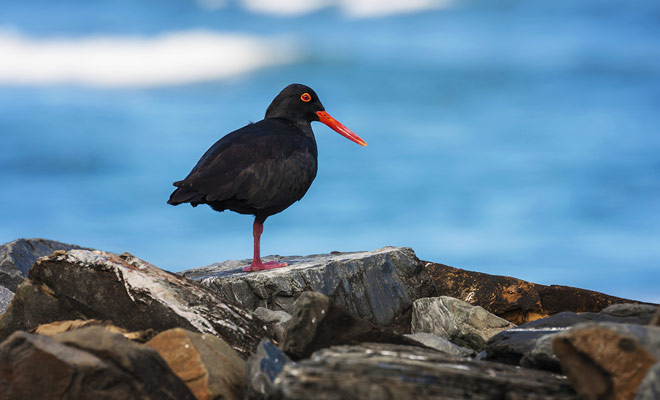
The Oystercatchers inhabit the beaches of Abel Tasman.
You will often encounter black birds with large colored legs on the beaches of Abel Tasman and Cathedral Cove. The Oystercatchers are searching for food in the sand. They are easy to photograph as they are estimated to number more than one hundred thousand individuals in the country.
Lake Matheson
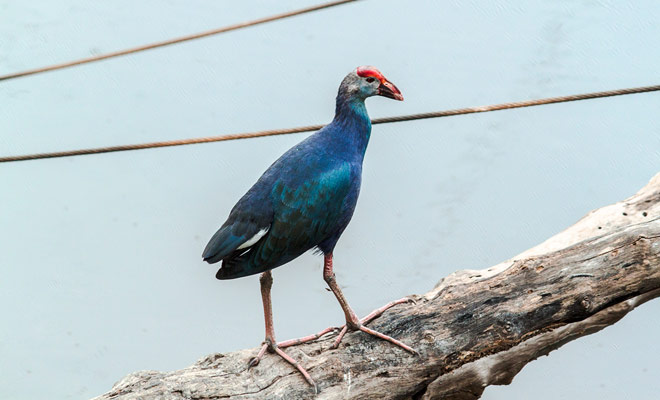
The pukeko lives mainly near swamps.
You will have to wake up early in the morning to admire the famous reflection of the Lake Matheson. But if the weather is bad, you can console yourself by watching a pukeko. This bird with a blue plumage and a red beak explores swamps to find its daily food.
Kaikoura Peninsula
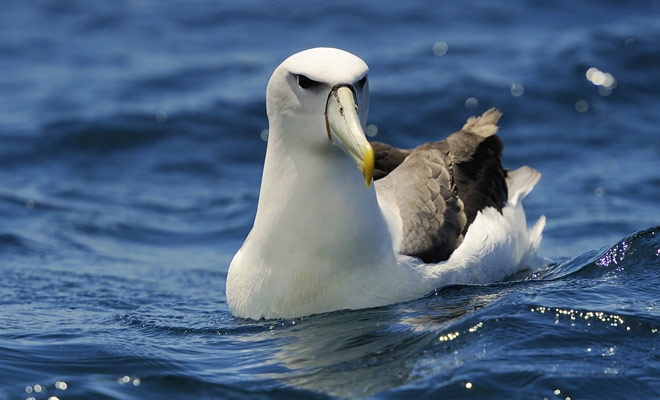
The albatrosses of the Kaikoura Peninsula.
You certainly did not decide to visit New Zealand to admire seagulls, although the presence of several thousand of them on the beaches of Kaikoura evokes the famous movie by Alfred Hitchcock, “the birds”.
More fascinating, albatrosses are more difficult to observe.
The Albatross Encounter tour operator proposes boat excursions to approach the albatrosses that fish offshore, and whose wingspan can reach three meters fifty!
Fiordland, Mount Cook, Fox Glacier

The Kea is the only mountain parrot in the world.
The kea is the only mountain parrot and also the most intelligent bird in the world. Curious and not very afraid by humans, the kea comes to meet you in the car parks to beg for food or to attack the rubber joints of your vehicle (an obsession that characterizes it).
Resist the urge to feed this protected specie that must absolutely retain its ability to feed itself alone in the wild.
West Coast
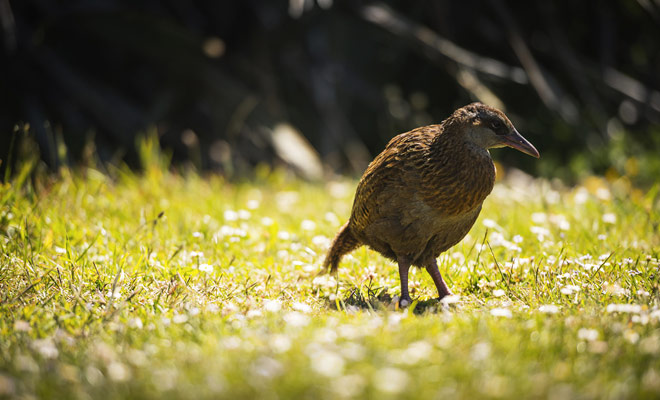
The weka is a stubborn and battling bird.
Unable to fly, stubborn and curious, the weka from the West Coast is at least as much loved as he is hated by New Zealanders.
Often confused with the Kiwi by tourists, he has nothing in common with the mascot of the country.
Able to put an incredible mess in an entire house to find food, the weka does not fear the humans he sometimes follows as a real pot of glue.
Exasperated, the Maoris often ended up passing the weka to the pan, hence its nickname “Maori chicken”.

You can observe wekas in the park of Paparoa.
The wekas are no longer as numerous as in the last century, but the species is not threatened and you will often encounter them in the West Coast. Be careful not to crush them by car, they have the annoying habit of crossing the road while ignoring the vehicles.
Meet the Fur Seals.
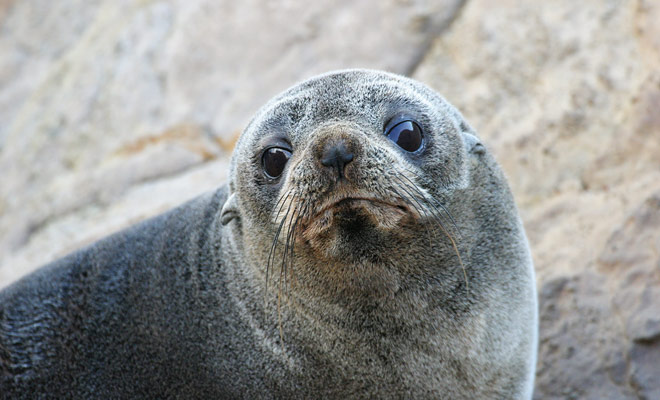
Fur seals inhabit the shores of the South Island.
The fur seals of New Zealand were close to extinction in the past century, but the protection of the species was ultimately successful. Observing these animals presents no difficulty and you will often encounter them on the shores of the South Island.
If the presence of a guide is not essential to approach fur seals, I advise you to observe a security distance of at least ten meters with these imposing creatures, if only for the smell (one can spend half his life in the water without smelling good), but mostly not to irritate the mothers who are very protective towards their babies.
It even happens that fur seals babies are emboldened to the point of climbing the kayaks!
The exploration of Abel Tasman National Park by kayak is a great classic that allows to admire the fur seals. They usually sunbathe on the rocks of Tonga Island, Pinnacle Island and Separation Point.
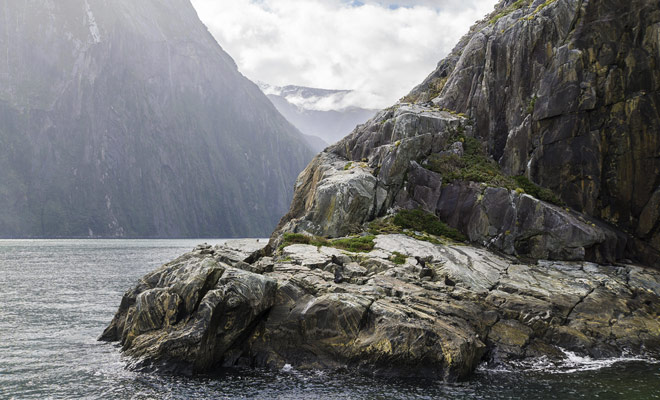
A fur seal colony lives on the rocks of Milford Sound.
In the even more spectacular panorama of the Milford Sound, the colony of fur seals is not systematically visible from cruise ships.
Once again, kayak is a better option, even if the price to pay will be higher!
Finally, travel guides often mention the presence of fur seals at Shag Point (not far from the Moeraki Boulders and Dunedin), but Kaikoura is the best spot: the peninsula has an impressive colony of fur seals and a well-hidden “nursery” (I will reveal the exact location on Kiwipal later).
Watch Whales for Real!
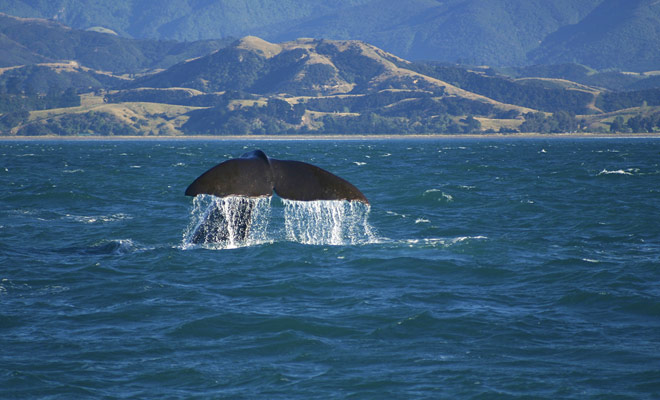
Whales are present all year round in Kaikoura.
Whales returning to the warm waters of the North are found off the Kaikoura Peninsula. In this exceptional setting where the mountains meet the ocean, cetaceans find abundant food in a gigantic submarine canyon.
Your chances of observing whales are close to 100% all year round!
Cruises are organized to approach the largest marine mammal on the planet, known as “giant sperm whales” because of an old scientific error. Of course, the tour organized by Whale Watch is not free and you will have to pay $145 per adult and 60 $ per child for the privilege of approaching the whales!
Fortunately, for this high rate you will often have the chance to observe shoals of dusky dolphins on the way.
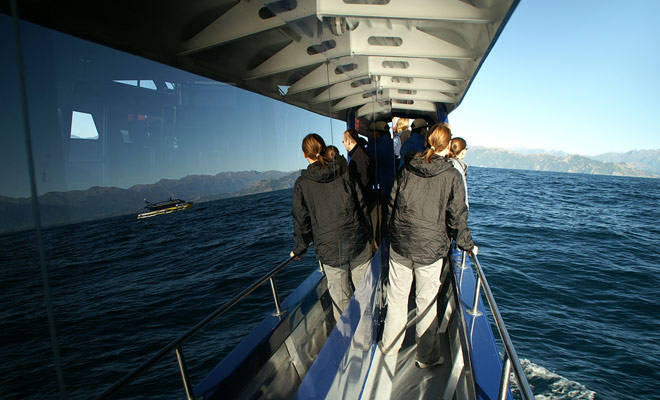
The chances of successfully observing whales are 99%!
The boats approach whales that surface and spat out their jet of water as you have already seen on TV.
But the real spectacle occurs when the whale plunges and its huge tail finally gives a glimpse of its gigantic size!
Some people are frustrated, however, to only spot only a “small part” of the whale.In this case, the ideal is to exchange the boat for a helicopter of the company “world of whales”. Seen from the sky and in fine weather, one can clearly distinguish the colossal form of the whale.

The helicopter is the best solution for whale watching.
A helicopter excursion allows to admire several whales and to benefit from the exceptional panorama of the peninsula. Alas! The activity that lasts a half hour only is a luxury that is not given to everyone (count $325 per person for a couple, and $220 per person if four passengers are present).
One often neglects to specify that the exits on a rough sea can give seasickness. Our article devoted to Kaikoura will bring you solutions to this recurring problem.
Swimming with Dolphins!
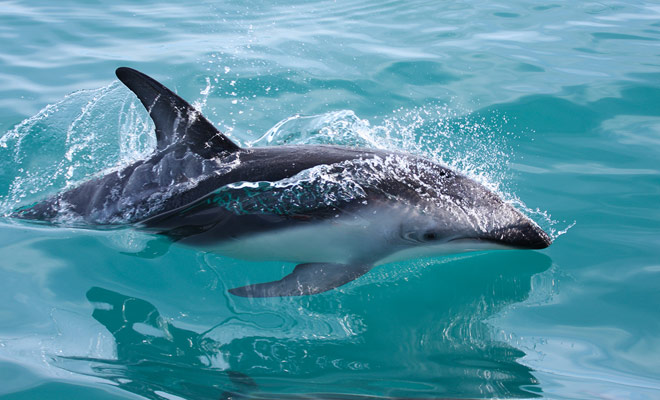
Swimming with dolphins is possible in New Zealand.
Swimming with dolphins is a popular activity in New Zealand. You can participate in an outing at sea both off the North Island and the South Island. However, the combination will be needed, except during the hot summer months (and in the north only).
You can also just watch dolphins without putting a toe in the water. Under these conditions, most organizers will offer a half-price discount.
Here's the ranking of the top three tour operators to swim with dolphins:
| LOCATION | ISLAND | COMPANY | ADULT | CHILD |
|---|---|---|---|---|
| Kaikoura | South Island | Encounter Kaikoura | 170 $ | 155 $ |
| Akaroa | South Island | Black Cat | $150 | $120 |
| Bay of Islands | North Island | Dolphin Cruises | $115 | $57 |
Swimming With Kaikoura Dolphins
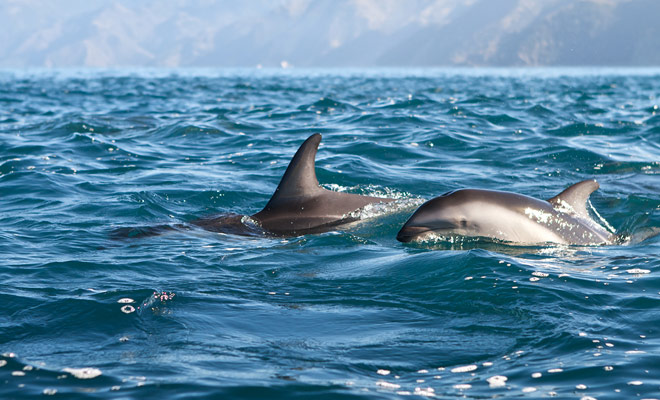
There are sometimes 200 dolphins together in Kaikoura.
The Kaikoura Peninsula attracts not only whales, but, in my opinion, is the best swimming spot with dolphins all over New Zealand. The shoals of dusky dolphins count up to two hundred individuals and are renowned to play with swimmers!
The Kaikoura Encounter's pricing is certainly higher than anywhere else in the country, but the quality of the experience is second to none. Only downside is the need to swim with a combination even in summer, as the water is a bit too cold.
Swimming With Akaroa Dolphins
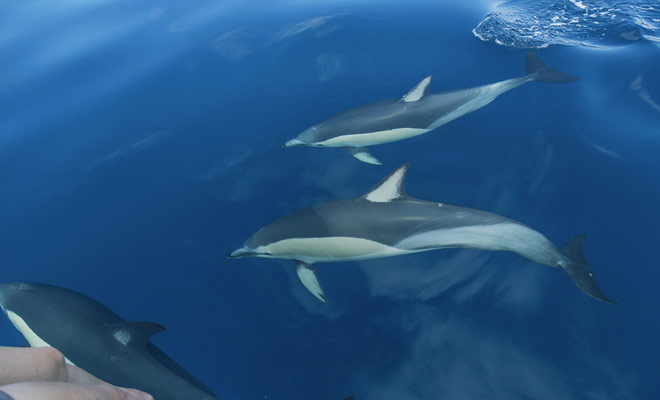
You can swim with the dolphins of Akaroa.

An excursion to go swimming with the dolphins of Akaroa (South Island).
A promo video of Black cat cruisesMost travelers are unaware of the existence of the only village founded by Frenchmen in New Zealand. Located on the Banks Peninsula, three quarters of an hour's drive from Christchurch, Akaroa is a jewel and the second-best spot in New Zealand to swim with dolphins.
The “Black Cat” company proposes an excursion (in swimming combination) of excellent quality. The little dog that climbs aboard the ship is called Captain Hector and his barking seem capable of replacing the sonar to locate the dolphins!
Swimming With Dolphins at Bay of Islands

Come and swim with the dolphins of the Bay of islands.
The Bay of Islands concentrates the largest number of tour operators dedicated to swimming with the dolphins. Departures are made indifferently from the cities of Paihia or Russell, but I recommend Russell, because the setting is magnificent.
I'm not a big fan of the very touristic activities, but Dolphin Cruise deliver a very professional service.
The water is warm enough in summer to bathe without combination but you can use one to feel more comfortable.
Once in the water, you should stir in all directions to attract the attention of the dolphins.
The Possum, a Public Enemy!

The possum destroys the vegetation of New Zealand.
It seems cute and inoffensive at first sight, but the possum is a veritable pest that devours the vegetation at a considerable speed. Not content with devastating the ecosystem, this small mammal also transmits rabies to cattle and kills birds.
Between the New Zealanders and the possum, it is a war without mercy!
The government injects 100 million dollars each year to exterminate this species. In less than fifteen years, the number of possums has decreased from 70 to 30 million in the country.
The poor beast, however, would need a lawyer, for it was the Westerners who introduced him in the country during the past century to trade the fur.
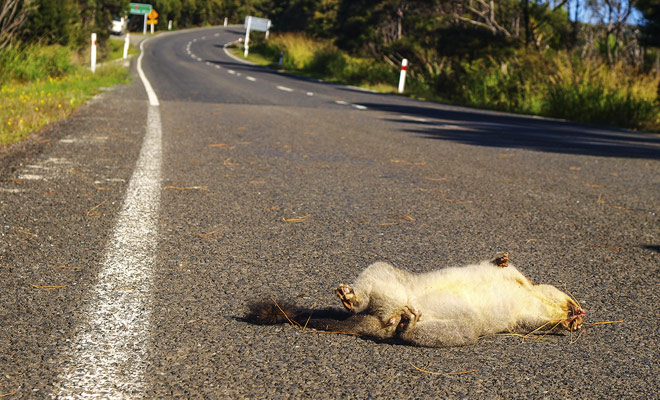
War is declared between the New Zealanders and the possums.
In reality, New Zealanders had the choice between fighting the possum or accepting the rapid disappearance of the country's forests.
The deforestation caused by the possum would have led to the mass extinction of hundreds of species of birds!
Should we press the accelerator as if a possum crossing the road? As a simple tourist, you can show mercy, but do not give food to a possum, a food that he does not need at all since he devours everything in its path!
Paradoxically unlikely, the species is now protected in Australia while being exterminated in New Zealand.
Observe Animals Without Disturbing Them.
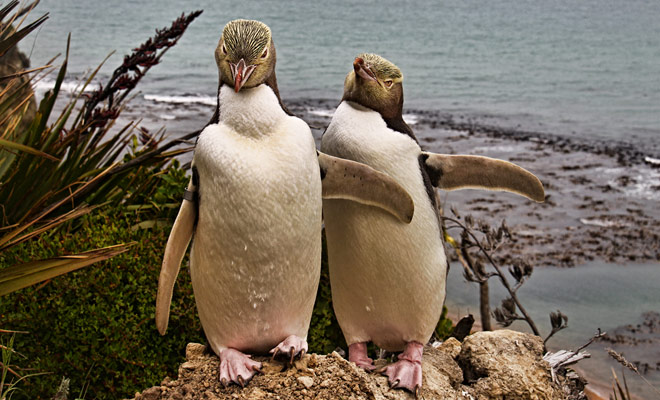
Yellow-eyed penguins on the shores of the South Island.
Some animals do not fear the presence of humans, but this does not protect you from a surprise bite. Most species are protected and it is forbidden to bother them under penalty of fines. Sometimes you must observe them from a distance, avoiding to reveal your presence.
Above all, there are behaviors to be avoided, for example to block the retreat of a fur seal towards the ocean, or to pass between parents and their babies.
The playful character of fur seals babies and their curiosity amuses the travelers, but it is better to keep distances to avoid irritating parents who are never far away.
In the list of bad habits, one finds especially the regrettable mania of nourishing the animals to get a better photo...
Of course, the animal is often the one who is demanding, but kea is not a pigeon and its claws are capable of damaging cars or disfiguring unwise humans.

Be careful not to disturb animals in New Zealand.
To admire the animals without disturbing them, you only have to bring a pair of binoculars (about thirty euros in sports shops). The binoculars allow you to observe timid species (such as penguins) by hiding yourself in shelters set up for this purpose by the Department of Conservation (DOC).
Therefore, there is a high probability of crushing a rabbit or some birds during your stay.
Forgive me for approaching the subject, but the road kills animal are legion, especially on the South Island. It is not always possible to avoid the poor beast that throws itself under the wheels of your vehicle ...

Be vigilant on the road not to crush animals.
So do not take inconsiderate risks to avoid a hedgehog if there is traffic on the road behind you! In reality, many accidents are not due to collisions with animals, but to a sudden change of trajectory and speed.
If you encounter an injured animal during a hike or by the roadside, call the toll-free number of the DOC (0800 362 468).
New Zealand, a Country With 30 Million Sheep.
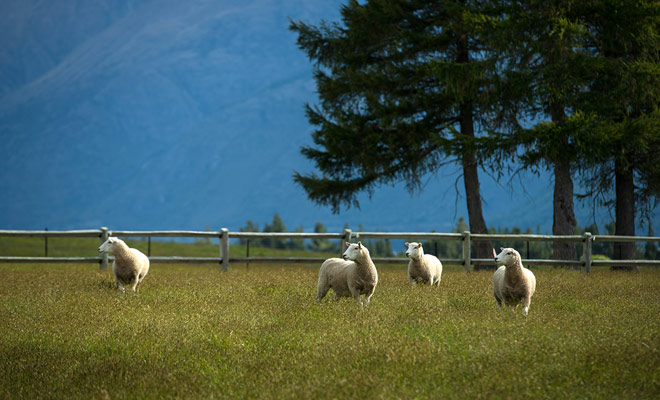
There are about 30 million sheep in New Zealand.
There are nearly 30 million sheep in New Zealand, not 70 million, as can be seen in obsolete guides (the figure was true 30 years ago). With a ratio of about seven sheep per inhabitant, you do not need my advice to cross their path.
Travelers sometimes imagine petting sheep or posing for a photograph with a cute lamb. But the sheep are usually very shy and will often run away as soon as you get off the car.
Attending sheep shearing is a popular activity in New Zealand, and you can even participate if you feel like it!
But if you will, I will leave aside our friends on all fours who are doing well, and talk about a last subject that is close to my heart. Threatened or endangered species are numerous in New Zealand.

You can make your contribution to help saving kiwis.
I encourage you to participate in the Kiwis protection program. Hunted by predators, Kiwis babies have only a 5% chance of survival in the wilderness, but the figure climbs to 65% if they are followed and protected during their growth.
The association “Kiwis for Kiwis” uses the money it collects to help kiwi babies flourish from the incubator to adulthood. If you would like to contribute, the website of the association will explain how your dollars will be spent. Even a small donation can save the life of a kiwi!
I hope this guide will help you to enjoy your stay in New Zealand. If you have any questions, I advise you to ask our friend Ben the Kiwi. And do not forget to send us your photos and your selfies with sheep!


Questions & Answers.

What can I do for you? The day I swam for the first time with the dolphins remained engraved in my memory. But there are so many animal species to discover in New Zealand ... If you need practical advice, I am at your disposal!
- All topics ... 26 answers in total
- Keas 4 answers
- Whales 4 answers
- Animals 3 answers
- Kiwis 3 answers
- Dolphins 3 answers
- Fur Seals 3 answers
- Sheeps 3 answers
- Possums 3 answers
Keas
- Why do kea attack cars?
They do not attack cars, but rubber joints of windows and mirrors. This may seem funny at first sight (especially if they are not destroying your own vehicle), but the damages can be significant, because the beak and the claws of this parrot are very sharp.
- Can we feed the keas?
You should never feed a kea, even if he comes to beg some food. The species is threatened and must keep its ability to survive without dependence on man for food.
- Is the kea really smart?
True studies have been conducted and it turns out that kea is the most ingenious bird when it comes to activate mechanisms to get food. It is enough to see him rummaging on the camping tables and open soda cans with his beak to realize just how clever he is.
- Is the kea dangerous?
The kea is not a common bird and its beak like its claws can cause serious injuries. There is no danger in watching a kea or letting it approach at a reasonable distance, but one must never try to touch it or even try to feed it.
Whales
- Are whales dangerous?
The strength of whales is no longer to be demonstrated, but they never attack ships in normal times. A whale would have to be intentionally wounded in order to attack the boat.
- What are the chances of seeing whales?
If you visit the Kaikoura Peninsula, chances are 99% year-round! You will be usually refunded by the organizer if you don't see whales.
- Is it possible to get a refund if no whales can be seen?
In Kaikoura, you will be refunded, but it is very rare that an expedition fails.
- Should we organize an outing if weather is bad?
I do not advise you, because the sea will be very agitated and the chances of suffering sea sickness will be higher. The mist (and to a lesser extent the rain) can make observation more difficult.
Animals
- Why are mammals rare in New Zealand?
New Zealand has gained its current position on the surface of the globe by drifting under the surface of the oceans for millions of years before emerging from the waves. Only birds could colonize this new virgin territory. In fact, all the mammals of the country have been introduced by man voluntarily or involuntarily.
- Are there venomous species in the country?
There are two small poisonous spiders, but only the Katipo can be deadly if you get stung. The antidote is found in all the pharmacies of the country, which is surprising, because this spider is practically extinct at the present time.
- Are there snakes in New Zealand?
No, there is no snake in the country.
Kiwis
- Why are Kiwis threatened with extinction?
The predators of the kiwi bird were introduced by the man, and the poor animal has no chances against a dog, his most dangerous opponent.
- How to observe a kiwi?
I recommend you to go out with a guide during the night (for example in Zealandia) or to go and watch the kiwis in the enclosure of Rainbow Springs in Rotorua.
- Can we help protect species?
The department of conservation (DOC) recruits volunteers to work in the wilderness. Such positions are highly sought-after, and competition is tough. If you wish to lend a helping hand, you can also make a donation to an animal welfare association.
Dolphins
- Can we swim with dolphins for free?
In a way ... because nothing prohibits you from swimming with dolphins if you rent your own boat. It is, however, advisable not to stay too long in the water, and not to seek contact if the dolphins keep their distance.
- Can we swim with dolphins of the Milford Sound?
It is possible to swim with the dolphins of Hector at the Milford Sound, admitting that they show themselves (there are only forty dolphins living in the fjord these days). I recommend you to opt for the kayak which already offers a fantastic experience, and you will be in the front row if the dolphins decide to make an appearance.
- Are dolphins disturbed when people swim with them?
It is precisely in order not to disturb the dolphins during their period of rest that schedules are respected by the cruises companies. Instructions that are not always respected (alas) by tourists who rent their own boat.
Fur Seals
- Are fur seals dangerous?
Females and sometimes even males (twice as large) do not hesitate to attack if they feel threatened, or if you approach too close to their babies. Stay at least at a dozen meters away (you will see them just as well) and never cut off access to the sea (their natural refuge in case of attack).
- What if a fur seals blocks my vehicle?
Using the car horn to scare the animal or get his attention is not only prohibited, but potentially dangerous. You should just wait patiently!
- What if a fur seals heads towards me?
If it is a baby and the parents are not in the vicinity, you can let the creature approaching. Baby seals are curious and sometimes come to sniff your shoes. Do not try to touch a fur seal, however. If it is an adult animal that is coming too close, keep your distance.
Sheeps
- How many sheep are there in New Zealand?
The number of sheep is estimated at about 30 million.
- Can one play with the sheep?
You will find that the sheep are very fearful and run away as soon as you get out of the car. Some breeders dislike to see tourists disturbing their flock and the lambs. A simple car horn is often enough to scare all the beasts.
- Is it difficult to shear a sheep?
One could almost speak of parallel national sport in New Zealand, but knowing how to handle the lawnmower with dexterity is not something that one can improvise. However, you will be able to learn or simply attend a mowing all over the country.
Possums
- Possum or opossum?
This is not a stupid question and everyone thinks it is a spelling mistake, but this is not the case. It is not actually the same species! In New Zealand there are possums and not opossums.
- What if I crush a possum with my car?
If the animal's body is not likely to create an accident, continue on as if nothing had happened and trust the predatory birds to do the cleaning.
- What is the famous steak game?
By car, the one who spotted a crushed animal on the road first earns a point. On journeys of 4 hours, scores of 15 against 20 are possible! (say what you want, but I bet you will play this game like everyone else!).

